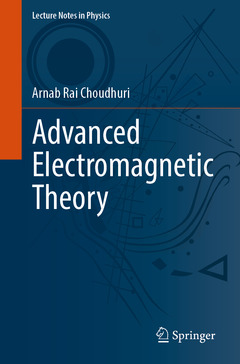Advanced Electromagnetic Theory, 1st ed. 2022 Lecture Notes in Physics Series, Vol. 1009
Auteur : Choudhuri Arnab Rai

This textbook provides a comprehensive one-semester course on advanced electromagnetic theory written from the modern perspective covering all important topics that a professional physicist needs to know. Starting from Maxwell's equations, electrostatics and magnetostatics, this book goes on to discuss such topics as relativistic electrodynamics, emission of electromagnetic radiation and plasma physics. It contains solved examples and exercises for students to highlight the concepts in each chapter.
Lecture 1 — Possibility of axiomatic formulation of electromagnetic Theory.
Basic equations, separation into electrostatics and magnetostatics in the absence
Lecture 2 — Electrostatic equations, electrostatic potential, Coulomb’s law,
Poisson’s equation. Potential and electric field due to a dipole and a uniform
dipole surface. Gauss’s theorem and applications.
Lecture 3 — Curvilinear coordiates, the Laplacian in cylindrical and spherical
coordinates. Uniqueness theorem for Laplace’s equation. Method of images,
point charge in front of plane surface and sphere.
Lecture 4 — Boundary value problems in two-dimensional Cartesian and
polar geometry, general solutions and specific examples.
Lecture 5 — Boundary value problems in axisymmetric spherical geometry,
Legendre polynomials. Multipole expansion for an axisymmetric distribution of
charges.
Lecture 6—Dielectric medium: electric polarization, basic equations, boundary
conditions. Dielectric sphere in uniform electric field. Energy density of
Lecture 7 — Basic equations, vector potential, Biot-Savart law, Ampere’s law.
Techniques for solving magnetostatic problems. Magnetic field due to localized
currents.
Lecture 8 — Multipole expansion of magnetostatic fields, magnetic moment.
Waves
Lecture 9 — Maxwell’s equations, charge conservation, significance of Faraday’s
law of electomagnetic induction. Energy and momentum of electromagnetic
fields, electromagnetic field tensor.
Lecture 10 — Electromagnetic waves in non-conducting medium, polarization,
Stokes parameters. Electromagnetic waves in conducting medium, skin
depth.
Lecture 11 — Reflection and refraction at an interface between two media,
Fresnel formulae, Brewster’s law, total internal reflection.
Lecture 12 — Rectangular wave guides, interior equations and boundary
Lecture 13 — Lorentz transformation, transformation of velocities, aberration
of light. Introduction to tensors. Special relativity in 4-vector notation, Doppler
effect.
Lecture 14 — Relativistic mechanics, velocity 4-vector and 4-momentum.
Covariant formulation of electrodynamics, 4-potential, electromagnetic field tensor,
Maxwell’s equations in covariant notation.
Lecture 15 — Transformation of electromagnetic fields, Lorentz 4-force. Action
Lecture 16 — Gauge freedom, Lorentz gauge, inhomogeneous wave equation.
Solution of inhomogeneous equations by Green’s function.
Lecture 17 — Retarded potential, Lienard–Wiechert potential. Calculation
of the electromagnetic field due to a moving charge.
Lecture 18— Electromagnetic radiation emitted by accelerated charges, Larmor’s
formula. Radiation from oscillating currents, centre-fed linear antenna.
Dipole approximation in radiation emission.
Lecture 19 — Radiation from oscillating dipole. Thomson scattering due to
free electrons. Radiation reaction.
Lecture 20 — Harmonically bound electrons and Rayleigh scattering. Relativistic
Lecture 21 — Different approaches to plasma physics. Debye shielding and
quasi-neutrality. Electromagnetic oscillations in cold plasmas, plasma frequency,
propagation of electromagnetic waves.
Lecture 22 — The MHD approximation, basic equations of MHD, induction
equation. Significance of magnetic Reynolds number, theorem of flux freezing,
applications to astrophysics.
Lecture 23 — Plasma confinement with magnetic fields in cylindrical geometry,
qualitative introduction to plasma instabilities. MHD waves in uniformly
magnetized plasma.
Arnab Rai Choudhuri is Professor of Physics at the Indian Institute of Science. He obtained his PhD from the University of Chicago in 1985. He is a theoretical astrophysicist who has worked on problems such as the formation of sunspots and the generation of the 11-year sunspot cycle by the dynamo process. He is one of the originators of the flux transport dynamo model, the currently favoured theoretical model of the sunspot cycle. Choudhuri is the author of two advanced textbooks, The Physics of Fluids and Plasmas: An Introduction for Astrophysicists (1998, Cambridge University Press) and Astrophysics for Physicists (2010, Cambridge University Press), as well as a popular science book, Nature's Third Cycle: A Story of Sunspots (2015, Oxford University Press).
Provides a comprehensive one-semester course on advanced electromagnetic theory written from the modern perspective
Presents in a compact manner advanced topics of electromagnetic theory which every professional physicist should know
Contains solved examples and exercise for students to highlight the concepts in each chapter
Date de parution : 01-2023
Ouvrage de 302 p.
15.5x23.5 cm
Thèmes d’Advanced Electromagnetic Theory :
Mots-clés :
Electrostatic Equations; Electrostatic Potential; Electric Polarization; Energy Density; Magnetostatics; Biot-Savart Law; Gauss’s Theorem; Laplacian in Cylindrical Coordinates; Maxwell’s Equations; Electromagnetic Field Tensor; Lorentz Transformation; Retarded Potential; Lienard–Wiechert Potential; Debye Shielding; Magnetohydrodynamics; Thomson Scattering



